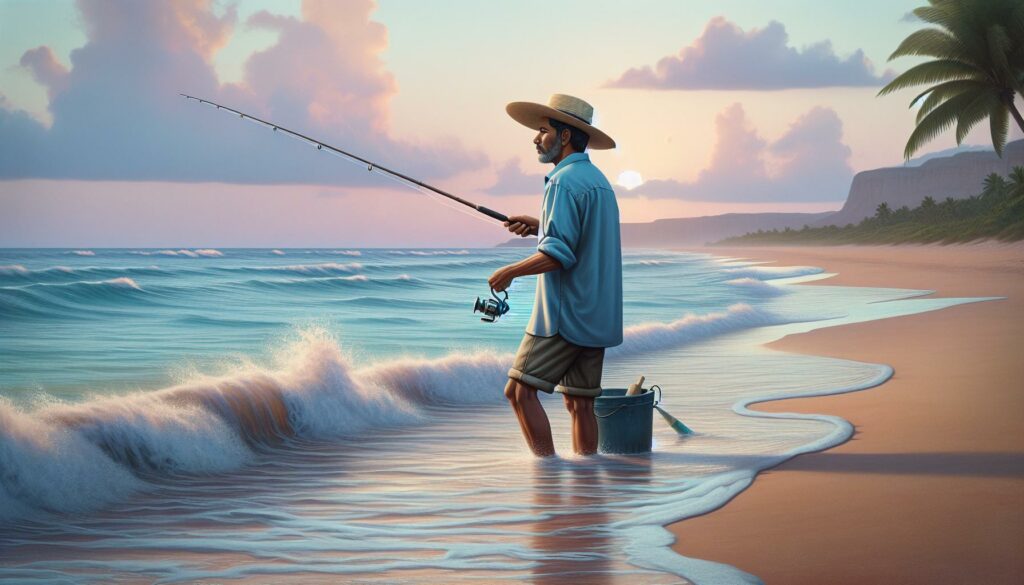There’s something magical about fishing at the beach. The sound of waves crashing and the salty breeze instantly create a sense of tranquility. Whether you’re a seasoned angler or just starting out, beach fishing offers a unique experience that combines the thrill of the catch with the beauty of nature.
I’ve spent countless hours casting my line into the surf, and each trip brings new adventures. From the excitement of reeling in a big catch to the peaceful moments spent watching the tide roll in, Beach:j6s2ilbfnoe= Fishing is more than just a hobby—it’s a way to connect with the ocean. In this article, I’ll share some tips and insights to help you make the most of your beach fishing excursions.
Key Takeaways
- Unique Experience: Beach fishing offers a combination of adventure and tranquility, allowing anglers to enjoy nature while catching various fish species.
- Essential Gear: Use surfcasting rods between 9 to 12 feet, reliable reels, and a variety of live and artificial baits to improve your fishing success.
- Tidal Knowledge: Understanding tidal patterns—high, low, and incoming tides—is crucial for effective fishing, as fish behavior varies with these changes.
- Prime Locations: Some of the best U.S. beach fishing spots include Cape Cod, the Florida Keys, and Huntington Beach, each known for specific fish species and conditions.
- Environmental Responsibility: Practice sustainable fishing techniques such as catch and release, adhering to local regulations, and using eco-friendly materials to protect marine habitats.
Beach:j6s2ilbfnoe= Fishing
Beach:j6s2ilbfnoe= Fishing combines adventure with relaxation in a unique setting. This activity allows me to connect with nature while enjoying the rhythmic sound of waves and fresh ocean air. Beach fishing targets various species, including surfperch, striped bass, and flounder, depending on the location and season.
I often equip myself with surfcasting rods that range from 8 to 12 feet for optimal casting distance. Bait selection plays a crucial role; using live bait like sand crabs or fresh cut bait increases chances of catching fish. Additionally, my tackle box contains essentials such as hooks, sinkers, and lures specifically designed for beach conditions.
Time of day significantly affects fishing success. Early mornings and late evenings provide the best opportunities for bites, especially during the warmer months when fish are more active near the shore. Observing tidal patterns and current flow also aids in identifying productive fishing spots, as these factors influence fish behavior.
Fishing regulations vary by region, so reviewing local guidelines ensures compliance while protecting the ecosystem. I recommend carrying a fishing license and following bag limits to maintain sustainable practices.
Ultimately, beach fishing offers an immersive experience that combines serenity with the thrill of the catch. Sharing this passion with fellow anglers enhances the experience, as we exchange tips, stories, and camaraderie under the sun.
Equipment Needed
Beach:j6s2ilbfnoe= Fishing requires specific equipment to ensure a successful and enjoyable experience. The right gear enhances both comfort and effectiveness during fishing trips.
Fishing Rods and Reels
Fishing rods for beach fishing should be at least 9 to 12 feet long. Longer rods allow for better casting distance, which is crucial for reaching fish in deeper waters. A medium to heavy power rod with a fast action tip is ideal for handling larger species like striped bass. Pair the rod with a suitable spinning or baitcasting reel designed to withstand saltwater conditions. Look for reels with a good drag system, capable of managing the fight of bigger fish. Spool the reel with braided line of 20 to 30-pound test for optimal strength and sensitivity.
Bait and Lures
Selecting the right bait and lures can significantly impact fishing success. Live bait options include sand crabs, blood worms, and minnows, which attract various species. For artificial lures, choose soft plastics, spoons, and topwater plugs that mimic local baitfish. Color choices often depend on water clarity; I’d opt for brighter colors in murky waters and more natural shades in clearer conditions. Experimenting with different licenses can provide insights into what works best for specific locations and species targeted.
Techniques for Success
Employing effective techniques enhances beach fishing success. Mastering various casting methods and understanding tidal patterns makes a significant difference.
Casting Techniques
Utilizing precise casting techniques improves catch rates. I recommend these strategies:
- Overhead Cast: Use this for distance. Position the rod behind your shoulder and flick it forward while releasing the line.
- Sidearm Cast: Great for accuracy in tight spaces. Keep the rod parallel to the water and swing it horizontally to the side.
- Pendulum Cast: This method builds momentum. Swing the rod in a smooth arc before releasing the line, ideal for long distances.
Practice each technique to determine which works best for your setup. Adjusting your casting method based on wind direction and bait type can lead to better results.
Tidal Considerations
Understanding tidal patterns is crucial for successful beach fishing. I focus on these factors:
- High Tide: This often brings fish closer to shore, making it a prime time for action. I find surfperch particularly active during this period.
- Low Tide: Fish move away to deeper areas. It’s still possible to fish, but targeting structures like sandbars or rocky outcrops increases chances.
- Incoming Tide: Fish tend to feed as the tide comes in. I’ve noticed species like striped bass become more active during this time.
Check local tide charts to align fishing trips with optimal times. Monitoring the stages of the tide enhances overall success and enjoyment.
Best Beach Locations
Exploring the best beach locations for fishing enhances the overall experience. The right spot can lead to a successful catch and unforgettable moments.
Top U.S. Beaches for Fishing
- Cape Cod, Massachusetts
Cape Cod offers diverse species such as striped bass and bluefish. It’s famous for its surfcasting opportunities, especially during early mornings. - Florida Keys, Florida
The Florida Keys attract anglers with their rich marine life, including tarpon and permit. The clear waters and abundant reefs create ideal conditions for fishing. - Huntington Beach, California
Huntington Beach features extensive sandy shorelines and vibrant surfperch populations. Local anglers recommend fishing near the pier for the best results. - Ocean City, Maryland
Ocean City hosts annual fishing tournaments and is known for flounder and rockfish. The area’s piers and jetties provide excellent access points. - Galveston, Texas
Galveston offers access to deep waters and targets species like redfish and speckled trout. The beachfront provides numerous fishing opportunities year-round.
- Cabo San Lucas, Mexico
Cabo San Lucas is renowned for marlin fishing. Local charters allow easy access to deep-sea fishing in stunning coastal waters. - Bondi Beach, Australia
Bondi Beach attracts surf anglers targeting bream and flathead. The lively atmosphere and scenic views enhance the fishing experience. - Nassau, Bahamas
Nassau’s crystal-clear waters are perfect for catching bonefish and snapper. The area’s flats and reefs provide rich fishing grounds. - Seychelles, Indian Ocean
The Seychelles is a paradise for fly fishing, especially for giant trevally. The remote islands offer pristine conditions and stunning landscapes. - Krabi, Thailand
Krabi features unique limestone formations and turquoise waters, attracting anglers seeking barramundi and grouper. The diverse ecosystems make it a fishing hotspot.
Environmental Considerations
Maintaining ecological balance during beach fishing is crucial. Protecting marine habitats ensures sustainability and long-term fishing opportunities. I adhere to strict guidelines to minimize my environmental impact, making my beach days enjoyable while safeguarding nature.
I practice catch and release methods for species that are not intended for consumption. Releasing fish quickly helps maintain populations and supports the ecosystem. Using barbless hooks also aids in minimizing injury to fish, promoting their survival upon release.
I’m mindful of local regulations, which reflect efforts to preserve fish stocks and habitats. Understanding size and bag limits keeps me informed about sustainable practices. I check for any seasonal restrictions to allow specific fish species to reproduce without disturbance.
I avoid using harmful materials, such as plastic lines and lures that may contribute to ocean pollution. Opting for biodegradable options whenever possible is part of my commitment to a healthier environment.
I also take care to avoid areas that may be habitats for nesting shorebirds. Staying clear of dunes and tidal flats helps protect vulnerable wildlife during breeding seasons. Educating myself about local biodiversity enhances my appreciation of the ecosystems I engage with.
Lastly, I often participate in beach clean-ups and encourage others to do the same. Ensuring the beach remains litter-free improves the environment for both wildlife and fellow anglers, supporting a shared responsibility for natural spaces.
The Thrill of Fishing
Beach fishing isn’t just about the catch; it’s about the entire experience. The soothing sounds of the ocean and the thrill of reeling in a fish create lasting memories. I’ve found that every trip to the beach offers something new whether it’s the excitement of a big catch or the peace of a quiet morning by the shore.
Connecting with nature through this activity has deepened my appreciation for the environment. By practicing responsible fishing and respecting local ecosystems, I know I’m contributing to the sustainability of our beautiful beaches. So grab your gear and head out to the shore; the adventure awaits.

